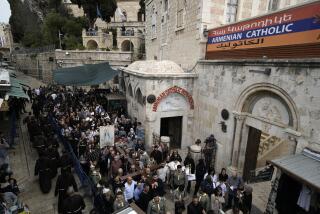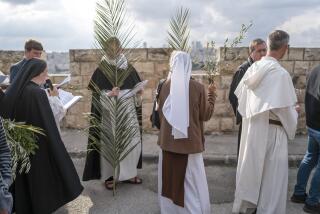Scholar Sees 1st Palm Sunday as a Political Protest Rally
- Share via
JERUSALEM — It’s a scene familiar to generations of Christians, one immortalized in art and song. Jesus rides a donkey along a dusty trail over the Mount of Olives and through the Kidron Valley to the gates of the city. Jerusalemites line the way, waving palm fronds and singing hymns.
It’s the right picture of the first Palm Sunday--but the wrong image, according to biblical scholar James Fleming. “Get out of your mind the peaceful, pastoral setting,” he advised.
To Fleming, the Christian director of the non-denominational Jerusalem Center for Biblical Studies and Biblical Research, the first Palm Sunday was essentially a political protest rally. The center will host some of the 50,000 Christian tourists expected in Israel during this Easter season.
Fleming depicts the scene in Jerusalem during that long ago Holy Week as one of enormous political tension. Judea at that time was “the most taxed nation the world has ever seen,” he said. “The lowest tax bracket was 80%.”
Pilate was a corrupt ruler determined to show his Jewish subjects who was boss, he said. Antonia Fortress, housing Jerusalem’s Roman garrison, stood taller than the holy Temple--an affront to the Jews.
The Gospels describe Jesus’ entry into Jerusalem in ways that would suggest the fulfillng Hebrew scriptural references to a messiah figure. Although some New Testament scholars feel the narratives were theologically motivated at this point and others in the gospels--rather than reliably historical--Fleming accepts the traditional view that some residents of the city saw in Jesus a political, if not religious, Messiah.
Moreover, the New Testament Gospels say Jesus came to Jerusalem for Passover, the Jewish celebration marking the exodus of their ancestors from slavery in Egypt. It would have been a time of particularly intense nationalistic feeling, Fleming argued.
A native of Portland, Ore., who grew up in Los Angeles, Fleming, 41, has lived and studied in Jerusalem for a decade. He has been director of the biblical center for half that time and also teaches historical geography and biblical archeology at Hebrew University.
More to Read
Sign up for Essential California
The most important California stories and recommendations in your inbox every morning.
You may occasionally receive promotional content from the Los Angeles Times.










